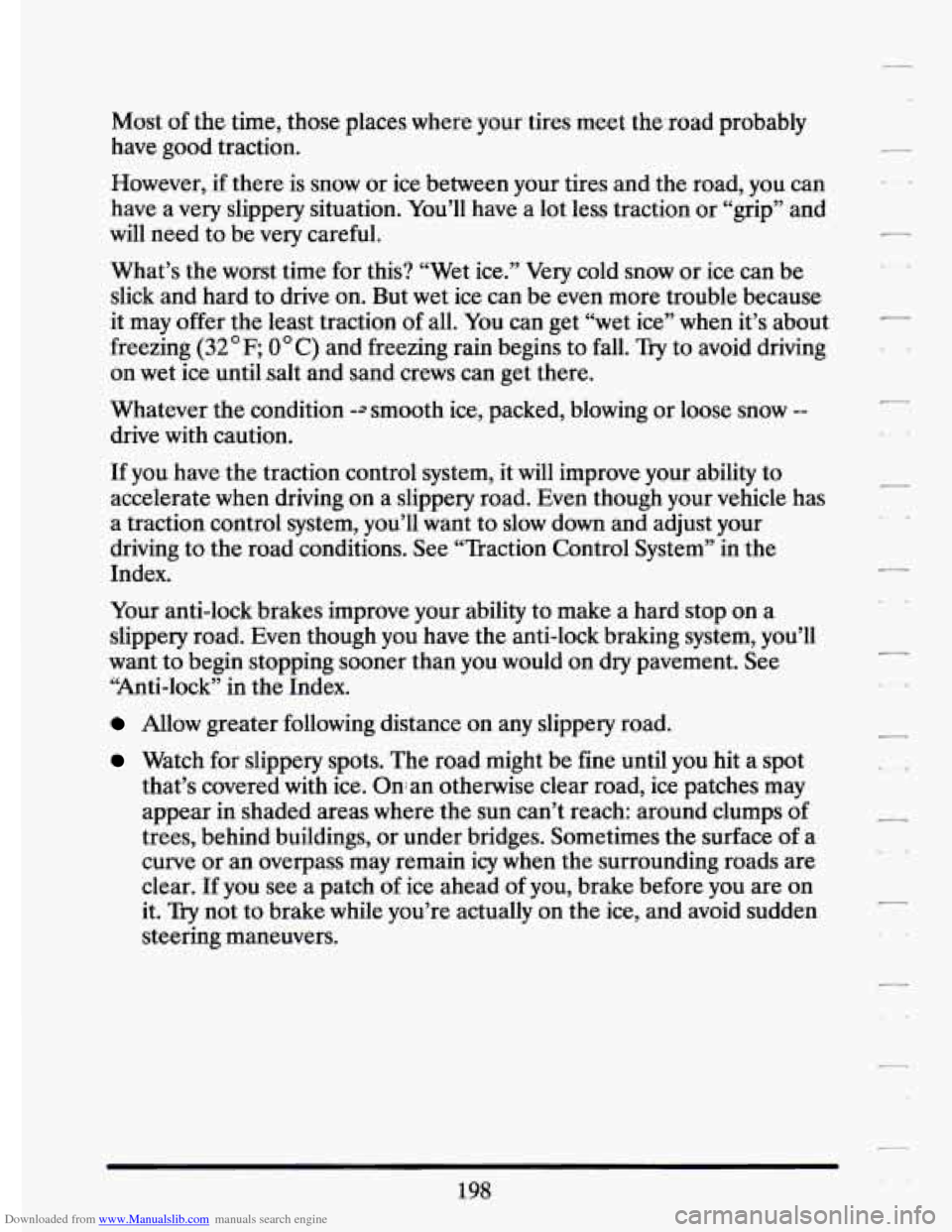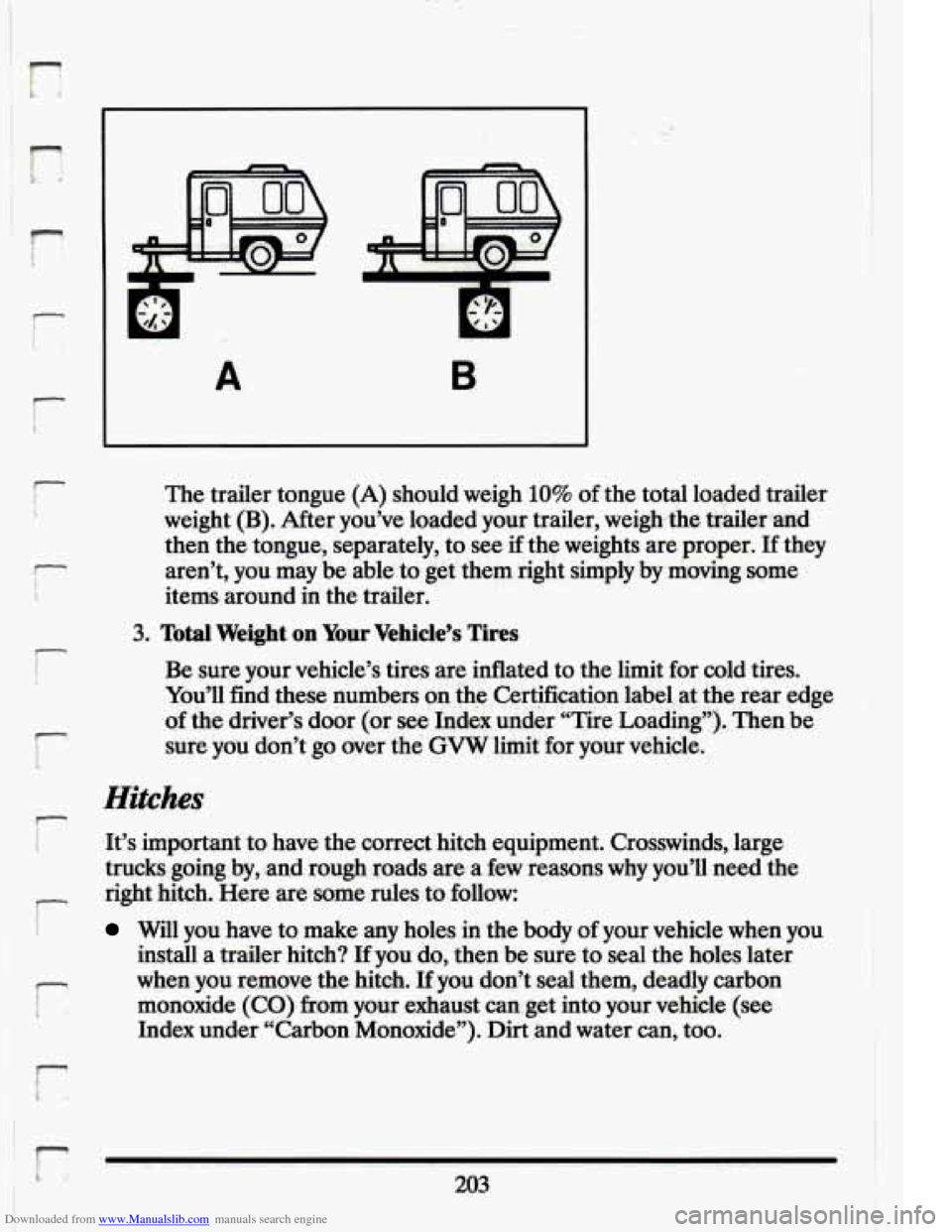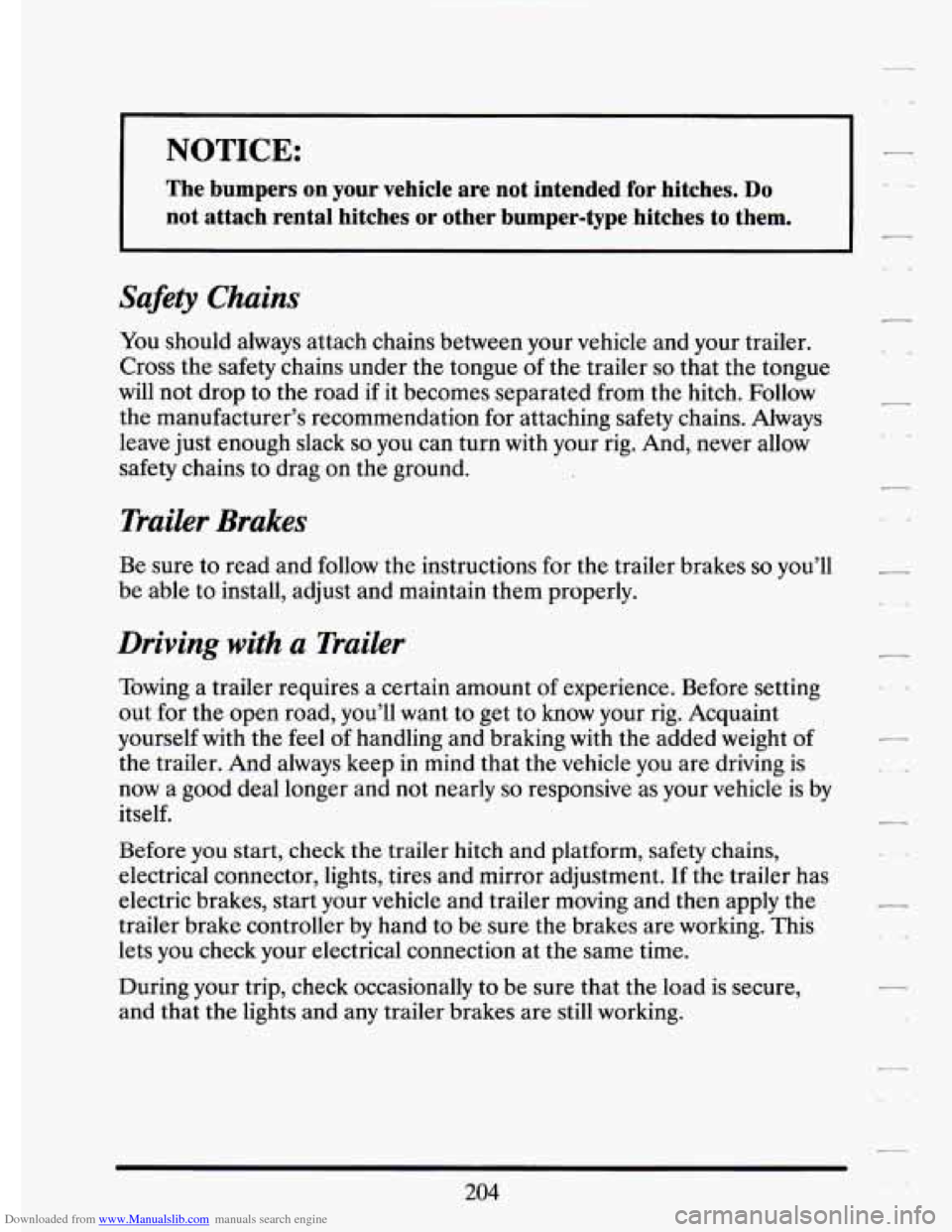Page 206 of 398
Downloaded from www.Manualslib.com manuals search engine HILL AND MOUNTMN ROADS
Driving on steep hills or mountains is different from driving in flat or
rolling terrain.
If you drive regularly in steep country, or if you’re planning to visit there,
here are some tips that can make your trips safer and more enjoyable.
Keep your vehicle in good shape. Check all fluid levels and a\
lso the
brakes, tires, cooling system and transaxle. These parts can work hard
on mountain roads.
Know how to go down hills. The most important thing to know is this:
let your engine do some of the slowing down. Shift to a lower gear
when you go down a steep
or long hill.
194
Page 210 of 398

Downloaded from www.Manualslib.com manuals search engine Most of the time, those places where your tires meet the:roaa probably
have good traction.
However,
if there is snow or ice between your tires and the road, you can
have
a very slippery situation. You’ll have a lot less traction or “grip” and
will need to be
very careful.
What’s the worst time for this? “Wet ice.” Very cold snow or ice can be
slick and hard to drive on. But wet ice can be even more trouble because
it may offer the least traction of all. You can get “wet
ice” when it’s about
freezing
(32 F; 0 C) and freezing rain begins to fall. Try to avoid driving
on wet ice untihalt and sand crews can get there.
Whatever the condition -=smooth ice, packed, blowing or loose snow
--
drive with caution.
If you have the traction control system, it will improve your ability to
accelerate when driving on a slippery road. Even though your vehicle has
a traction control system, you’ll want to slow down and adjust your
driving to the road conditions. See “Traction Control System” in the
Index.
Your anti-lock brakes improve your ability to make a hard stop on a
slippery road. Even though you have the anti-lock braking system, you’ll
want
to begin stopping sooner than you would on dry pavement. See
“Anti-lock” in the Index.
Allow greater following distance on any slippery road.
Watch for slippery spots. The road might be fine until you hit a spot
that’s covered with ice. Oman otherwise clear road, ice patc\
hes may appear in shaded areas where the sun can’t reach: around clumps
of
trees, behind buildings, or under bridges. Sometimes the surface of a
curve or an overpass may remain icy when the surrounding roads are
clear.
If you see a patch of ice ahead of you, brake before you are on
it.
Try not to brake while you’re actually on the ice, and avoid sudden
steering maneuvers.
198
Page 213 of 398

Downloaded from www.Manualslib.com manuals search engine r
r
r
P
r
!
r I
r
r-
NOTICE:
Pulling a trailer improperly can damage your vehicle and result
in costly repairs not covered by your warranty. To pull a trailer
correctly, follow the advice
in this section.
Your Cadillac is a passenger vehicle. It was not designed for many of the
demands that trailer towing can add.. Trailer towing can change the way
your vehicle performs on the road. It brings new forces into play and can
add plenty
of strain and stress to your vehicle.
Load pulling components such as the engine, transaxle, wheel assemblies,
and tires are forced to work harder against the drag
of the added weight.
The engine is required to operate at relatively higher speeds and under
greater loads, generating extra heat. Trailer towing adds considerably to
wind resistance increasing the pulling requirements.
All
of that means changes in:
Handling
Durability
Fuel Economy
You may decide not to pull a trailer but meet your load carrying needs in
some other way.
201 I
I
Page 215 of 398

Downloaded from www.Manualslib.com manuals search engine P
r
r,
r
r
The trailer tongue (A) should weigh 10% of the total loaded trailer
weight
(B). After you’ve loaded your trailer, weigh the trailerand
then the tongue, separately, to see
if the weights are proper. If they
aren’t, you may be able to get them.right simply by moving-some
items around in the trailer.
3. Total Weight on Your Vehicle’s Tires
Be sure your vehicle’s tires are inflated to the limit for cold tires.
You’ll find these numbers on the Certification label at the rear edge
of the driver’s door (or see Index-under “Tire Loading”). Then be
sure you don’t go over the
GVW limit for your vehicle.
r !
Hitches
It’s important to have the correct hitch equipment. Crosswinds, large
trucks going by, and rough roads are a few reasons why you’ll need the
right hitch. Here are some rules to
follow:
Will you have to make any holes in the body of your vehicle when you
install a trailer hitch?
If you do, then be sure to seal the holes later
when you remove the hitch.
If you don’t seal them, deadly carbon
monoxide (CO) from your exhaust can get into your vehicle (see
Index under “Carbon Monoxide”). Dirt and water can, too.
r i. .,
203
Page 216 of 398

Downloaded from www.Manualslib.com manuals search engine NOTICE:
The bumpers on your vehicle are not intended for hitches. Do
not attach rental hitches or other bumper-type hitches to them.\
-
Safety Chains
You should always attach chains between your vehicle and your trailer.
Cross the safety chains under the tongue of the trailer
so that the tongue
will not drop to the road
if it becomes separated from the hitch. Follow
the manufacturer’s recommendation for attaching safety chains. Alwa\
ys
leave
just enough slack so you can turn with your rig. And, never allow
safety chains to drag on
the ground.
Trailer Brakes
Be sure to read and follow the instructions for the trailer brakes so you’ll -
be able to install, adjust and maintain them properly. L:
Driving with a Trailer
Towing a trailer requires a certain amount of experience. Before setting
out for the open road, you’ll want to get to know your rig. Acquaint
yourself with the feel of handling and braking with the added weight of
the trailer. And always keep in mind that the vehicle you are driving is
now a good deal longer and not nearly
so responsive as your vehicle is by
itself.
Before you start, check the trailer hitch and platform, safety chains,
electrical connector, lights, tires and mirror adjustment. If the trailer has
electric brakes, start your vehicle and trailer moving and then apply the
trailer brake controller by hand to be sure the brakes are working. This
lets you check your electrical connection at the same time.
During your trip, check occasionally to be sure that the load is secure,
and that the lights and any trailer brakes are still working.
204
Page 229 of 398
Downloaded from www.Manualslib.com manuals search engine TOWING YOUR VEHICLE
r, Try to have a GM dealer or a professional towing service tow your
Cadillac. The usual towing equipment is a sling-type, or a wheel-lift, or
car carrier tow truck.
r
r
V
I n
t
ir
I 'r:
F-
i
17
r
A. Sling Type
B. Wheel Lift
C. Car Carrier
If your vehicle has been changed or modified since it was factory-new by
adding aftermarket items like fog lamps, aero skirting, or special tires and
wheels, these instructions and illustrations may not be correct.
Before you do anything, turn on the hazard warning flashers.
When you call, tell the towing service:
That your vehicle cannot be towed from the front or rear with
That your vehicle has front-wheel drive.
The make, model, and year of your vehicle.
Whether you can still move the shift lever.
If there was an accident, what was damaged.
sling-type
equipment.
217
Page 241 of 398

Downloaded from www.Manualslib.com manuals search engine !r
r
r
r L
I-
‘.. c ..e
IF A TIRE GOES FLAT
It’s unusual for a: tire to “blow out” while you’re driving, especially if you
maintain your tires properly. If air goes out of a. tire, it’s much more ‘likely
to leak out slowly.
But if you should ever have a “blowout,” here are a
few tips about what to expect and what to do:
If a front tire fails, the flat tire will create a drag that pulls the vehicle
toward that side. Take your
foot, off .the accelerator pedal and grip- the
steering wheel
firmly. Steer to maintain lane position, then-gently brake
to a stop well out of the traffic lane.
A rear blowout, particularly on a curve, acts much like a skid and may
require the same correction you’d use in a skid. In .any rear blowout,
remove your foot from the accelexator pedal. Get the vehicle under
control by steering the way
you want the vehicle to go. It may be very
bumpy and noisy, but you can still steer. Gently brake to a stop, well
off
the. road.if possible.
If a tire goes flat, the next section shows how to use your jacking
equipment to change a flat tire safely.
. . ._ .. . .
229
Page 250 of 398

Downloaded from www.Manualslib.com manuals search engine COMPACT SPm TIRE
Although the compact spare was fully inflated when your vehicle was
new, it can lose air after a time. Check the inflation pressure regularly.
It
should be 60 psi (420 kPa). The compact spare is made to go up to 3,000
miles (5000 km), so you can finish your trip and have your full-size tire
repaired or replaced where you want. Of course, it’s best to replace your
spare with a full-size tire as
soon as you can. Your spare will last longer
and be
in good shape in case you need it again.
Your anti-lock brake system warning light may come on when you are
driving with a compact spare. See “Anti-Lock Brake System Wa\
rning
Light”
in the Index.
r
NOTICE: -
Don’t take your compact spare through an automatic car wash
with guide rails. The compact spare can get caught on the rai\
ls.
That can damage the tire and wheel, and maybe other parts
of
your vehicle.
Don’t use your compact spare on some other vehicle.
And don’t mix your compact spare or wheel with other wheels or tires.
They won’t fit. Keep your spare and its wheel together.
238